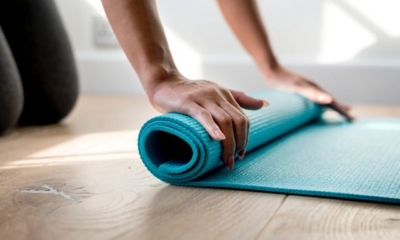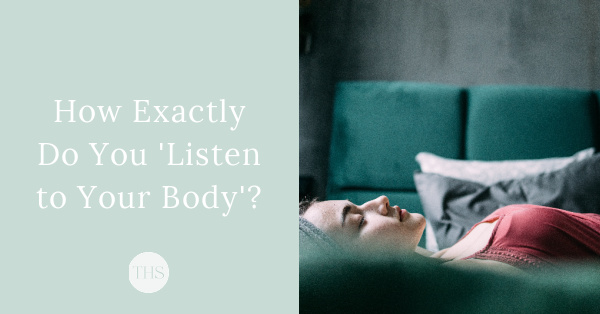6 Exercises for Chronic Health Conditions

It’s the advice we’ve all been given: listen to your body.
You should listen to your body to sense your boundaries, to take rest when you need it, to eat enough but not too much, to asses how your body reacts to different situations and to recognize when something is wrong.
And although there is a lot of wisdom to that, it’s also a little vague. Because so many of us live in our heads, not really aware of what’s going on in our bodies. Or if we do pay attention, then you may mostly notice the scary and painful sensations – especially when you’re chronically ill.
So how exactly do you “listen to your body”?
We all know the five senses that give us information about the outside world – our sight, sound, smell, taste and touch. But our bodies also track what’s happening inside of us, like our heart beat, expanding lungs and stomach movements, through the sense of interoception. Interoception gives us signals about hunger and thirst, whether we need to use the bathroom, and where we hold tension in our muscles.
We even have more internally-focused senses, like proprioception that lets us know where our body parts are in space without seeing them, thermoception to sense whether we or objects are hot or cold, nociception that signals pain, and equilibrioception, our sense of balance.
But when our minds are preoccupied with checking off to-do lists, real conversations and mental monologues, we don’t always notice the messages that our bodies are sending us. And even if we do pay attention, it can be hard to interpret these signals and understand what our bodies are communicating.
What can we do to improve our interoceptive awareness?
We’re all built differently, but here are some steps you can take to get more in tune with your body, and listen to what it has to tell you.
If you struggle with chronic illness, mental health problems or traumatic experiences, please read all the way to the end of the article to learn more about how to interpret signals and when *not* to listen to your body.

This article contains some affiliate links to products you may find useful, at no extra costs to you. All opinions are my own.
One of the easiest ways to start learning to listen to your body is by engaging your external senses.
You see, our brains constantly receive input from our five senses, but we only pay attention to a tiny fraction of those sensations. Partly that’s for a good reason – your brain’s already working hard to process information and filter out what’s relevant to you right now – but do you ever stop to notice what it really feels like to see, hear, smell, taste and touch?
Here are some simple ideas to tune into your senses:
By engaging your senses, you can practice becoming aware of all the sensations that your eyes, ears, nose, tastebuds and skin are providing. These external cues are often easier to interpret than internal signals like muscle tension and stomach pangs, but they do teach you to become more mindful and turn inward.

Another fun way to tune into your body is by working with your hands. Hands-on activities like drawing, kneading dough and gardening can be a tactile gateway to mindfulness. Researcher Kelly Lambert found that, by being present and focusing on the sensations of your fingers, you quiet your thinking mind while connecting to the (tangible) world around you, which results in less stress, anxiety and depression.
You can increase your body awareness with all kinds of hands-on activities, from painting, journaling and baking to wood work, building miniature houses and even washing the dishes by hand.
However, if you want to turn inward and learn to listen to your body, it is key that you don’t constantly distract yourself with music, podcasts or scrolling your phone while working with your hands.
To tune into your body and bigger muscle groups, it helps to pay attention to your posture. How do you hold yourself when you sit, stand and walk?
Throughout the day, observe your posture without any judgement, just see it as neutral information about your wellbeing. For example, if you catch yourself slouching behind your computer, that could be a sign of fatigue, weakened core muscles or simply a bad habit. Depending on what could be the cause, you can either take a short break, stretch your legs for a moment or adopt a better sitting position.
Another great way to become more aware of your posture is to practice grounding. On natural terrains that you can safely walk on, like grass, sand or soil, take off your shoes and place your feet on the ground. Notice how your toes and soles touch the surface, and how you stand. Do you tend to lean more on the inside or the outside of your feet? Is there tension in your ankles, knees or legs as you stand?
If you prefer to keep your shoes on, try to squeeze in a short walking meditation when you’re on a stroll. As you’re walking, zoom in on a single stride in your mind’s eye. Feel how your heel touches the ground before you roll onto the ball of your foot and lift your leg. Note how your weight shifts from one leg onto the other, and how your foot makes contact with the ground again. If your mind starts to wander, no problem, just bring your attention back to your steps for 5 to 10 minutes.
Minding your posture during daily tasks is a great example of how you can learn to listen to your body, and all the little clues it gives you about your wellbeing.

We move our bodies all day long, but often without really paying attention to our motions, gestures and poses. And if we do, it’s probably in the form of exercising in the gym, with the goal of getting fit, lean or strong.
Intentional movement is the practice of moving your body mindfully. Instead of just going through the motions, you focus on the way you move and the sensations you experience. Sometimes, this process can be aided by focusing on your breathing and purposely letting go of tension in your muscles.
Yoga is the poster child practice of slow, intentional movement, but you could also try Pilates, t’ai chi, intuitive dancing or mindful running – basically any form of exercise that allows you to bring your awareness to how your body feels as you move.
Ok, so you are more aware of what you see, hear, smell, taste and sense, and how you move your body. But when it comes to listening to your body so you can avoid burnout, flare-ups and post-exertional malaise, how do you detect issues like tension, pain and other uneasiness?
Progressive muscle relaxation is a mind-body practice that can help you get better at that. By purposely flexing your muscles and then relaxing them, over time it gets easier to spot how you feel, where you hold tension in your body and what you can do to release it.
Studies show that regularly doing progressive muscle relaxation reduces neck and back pain, improves sleep and lowers your blood pressure. Take a look at this guide from Healthline how you can try this technique at home too.
As helpful as walking meditations and progressive muscle relaxation are, the questions remains, do you listen to your body throughout the day, when you’re busy doing other things?
One way of tuning into your body regularly is by doing a mindful body scan. A body scan is like a guided tour in your mind’s eye, from your toes to the top of your head.
When you first get started with this practice, find a quiet spot to sit or lie down. Close your eyes and bring your awareness to your feet. Feel where your heel touches the ground, whether your toes are warm, cold or tingly, if the tiny muscles in your feet are relaxed or tense. Next, turn your attention to your ankles and lower legs. Slowly, keep moving your focus upwards, while pausing at each body part to pay attention to the sensations in it.
Aside from looking out for physical sensations, you may also notice how your body responds to the thoughts and emotions you’re experiencing. Maybe you feel pangs in your abdomen when you’re nervous or anxious, or you get a lump in your throat when you’re sad and overwhelmed. Understanding your own mind-body patterns can help you to respond better to situations and avoid a build-up of stress and emotions.
After practicing a mindful body scan in a quiet place for a while, you’ll start to get the hang of it and will be able to do a quick scan as you’re sitting in your chair, waiting in line or going about your day.

If we have a spare moment in our days, so many of us grab our phones or put some music on – anything to keep our minds engaged. But the less present we are in the moment, the less in touch we are with how our body feels.
So don’t fill every minute of silence and solitude, but learn to enjoy daydreaming again. Set some simple ‘rules’ for yourself, like no screens at meal times or turning off your devices one hour before bedtime, so there actually is time in your day to tune into your body and how you are feeling.
For some people it helps to have measurable data to better understand how their body is working. That’s when fitness trackers or health apps can be useful tools to grow your interoceptive awareness. Wearables can also help you to get more insight into causes, effects and patterns, and to watch your progress over time instead of relying on your (imperfect) memory.
However, there are a few things you have to keep in mind when using wearables to learn to listen to your body:
There’s no right or wrong here, so use wearables as tools to tune into your body if that fits your character and needs. Just stay aware of the potential downsides too.
No matter if you’re just learning to listen to your body or you’re well aware of what’s happening inside of you, it can be overwhelming and confusing to make sense of the signals that your body is sending.
Ok, so I feel I’m getting tired – is it a normal dip in my energy levels or a sign of overdoing it? Do I feel drained physically or emotionally? Should I take a rest, gently move my body to get re-energized or just continue on despite the fatigue?
Honestly, how to interpret the sensations of your body deserves a whole article of its own. For now, a few quick pointers:

It seems like ‘listen to your body’ is the kind of intuitive advice that work for everybody all the time. But in my opinion, there are definitely times when you shouldn’t take things at face value.
First of all, listening to your body implies that you always know how to interpret the signals and sensations in the right way. But that just cannot be the case when you realizes how many factors influence your wellbeing in intertwined ways – your genes and upbringing, your physical and social environment, your mindset and health habits, and much more. Especially when you’ve experienced major trauma or struggled with eating disorders, it can be hard to untangle the (mixed) messages your brain’s receiving.
What’s more, not every uncomfortable symptom is a bad sign. When your muscles are aching after a physical therapy session or tiring day, that doesn’t have to mean you pushed your body too far – the pain can also be a signal that you’re rebuilding your strength and fitness. And it’s not always easy distinguishing the subtle differences between these ‘good’ and ‘bad’ pain sensations.
For some people, turning their attention towards their bodily sensations makes them anxious and worried about their health. If your mind immediately starts racing about all the things that could be wrong with you when you experience symptoms, then it can be more helpful to learn how to cope with your fears than to figure to what exactly your body’s telling you.
For others, focusing on bodily sensations makes them all too aware of the nausea, exhaustion or trembling legs they’re feeling. And we all know that can be awful. In that case, it can be to find a helpful balance between noticing these signals and distracting yourself to take your mind off your symptoms.
In all these cases, it’s wise not to listen to your body without also minding your thoughts and/or using other tools to interpret and manage your bodily sensations.
Noticing the signals that your body’s sending and interpreting them is not always easy, but you can learn to listen to your body in tangible ways, from engaging your five senses and working with your hands to intentional movement. You can also grow your interoceptive awareness by doing walking meditations, progressive muscle relaxation and mindful body scans.
Do you find it easy to listen to your body? What helps you to become more aware of what your body’s telling you?
For more ideas on how to listen to your body throughout, add these mindful-micro breaks to your daily routine and learn how to look out for warning signs your body’ sending you.